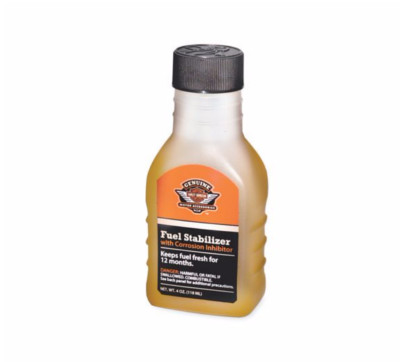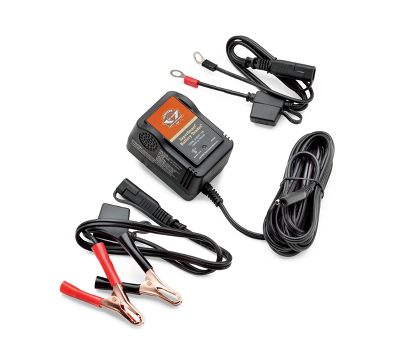
Tech Tips
Fuel Stabilizer

Steel fuel tanks, on carbureted or fuel-injected bikes, can rust inside if left to sit. It depends on various factors such as fuel quality and the level in the tank, fluctuations in air temperature and humidity, the condition of the inside of the tank surface. Most motorcycle mechanics and How-To sites recommend that you keep tanks at least 3/4 full with fuel stabilizer added. Fuel injection systems have less trouble with stale fuel, whereas fuel can evaporate inside a carburettor and leave a sticky residue behind. Ideal for winter storage and year-round use, Harley-Davidson® premium Fuel Stabilizer keeps fuel fresh for up to 12 months.
- 4 fl oz (118 ml) bottle
- Blended with corrosion inhibitors
- Formulated to protect fuel tanks, fuel lines, carburettors and injectors from long-term exposure to the adverse effects of ethanol-blended fuel
- Fights deposits that can accumulate as a result of ethanol-produced solvents
- Acts as a demulsifier to eliminate condensation in the fuel system
- 4 ounces treats 10 gallons of fuel
Battery Tender

Battery Tenders are a must for us motorcyclists in Alberta due to our relatively short riding season. Batteries in storage will lose their charge surprisingly fast. Especially if your bike is equipped with a security system. Our Harley-Davidson® battery tenders come with an adaptor that stays connected to your battery. Use the quick connector for easy charging. A Battery Tender will not overcharge your battery. Just plug it in and let it do the rest. Battery tenders are an inexpensive way to maintain your battery and prevent early replacement. Ask our service department to install a battery tender lead (adaptor) at your next visit.
Tire Pressure

Not an exciting subject - but a really important one. Your tires are the only thing connecting your motorcycle to the road, and tire pressure affects a lot of stuff like traction, handling, stability, ride comfort, and tread wear.
Checking tire pressures is the most fundamental of maintenance items, yet most riders fail to do it as often as they should. As a rule, you want to check your tires at least every other week. Make sure you're using a decent tire gauge, and check the tires when they're cold. That doesn't mean waiting until winter, it just means doing it before you ride since the tire will heat up as it rolls down the road. Left alone, your tires are going to deflate. Tubeless tires bleed down more slowly than tube-type tires but in any case the fact that air molecules find their way out of tires all on their own means that under-inflated tires are pretty common.
If your tire pressures are too low, then you end up with a soft tire and a big old contact patch. That leads to sloppy, heavy handling, premature wear, excess friction and tire temperature, and poor fuel economy. On the other hand, if your tire pressures are too high, you'll have a really small contact patch and a very hard tire. That means less traction and a rough ride.
So how do you know what the correct pressure is? The right place to look is in your owner's manual, or right on your motorcycle. There's likely a sticker on bike's swingarm or on the frame that lists the pressure for your particular bike.

